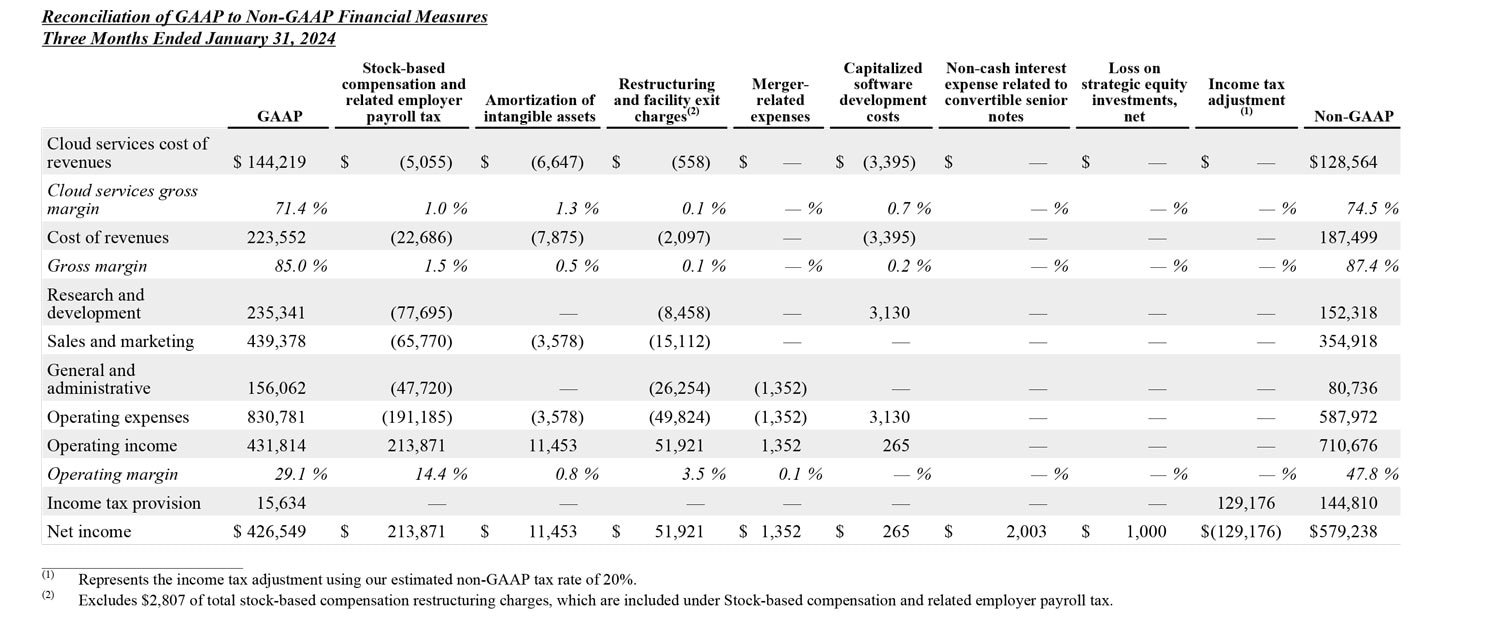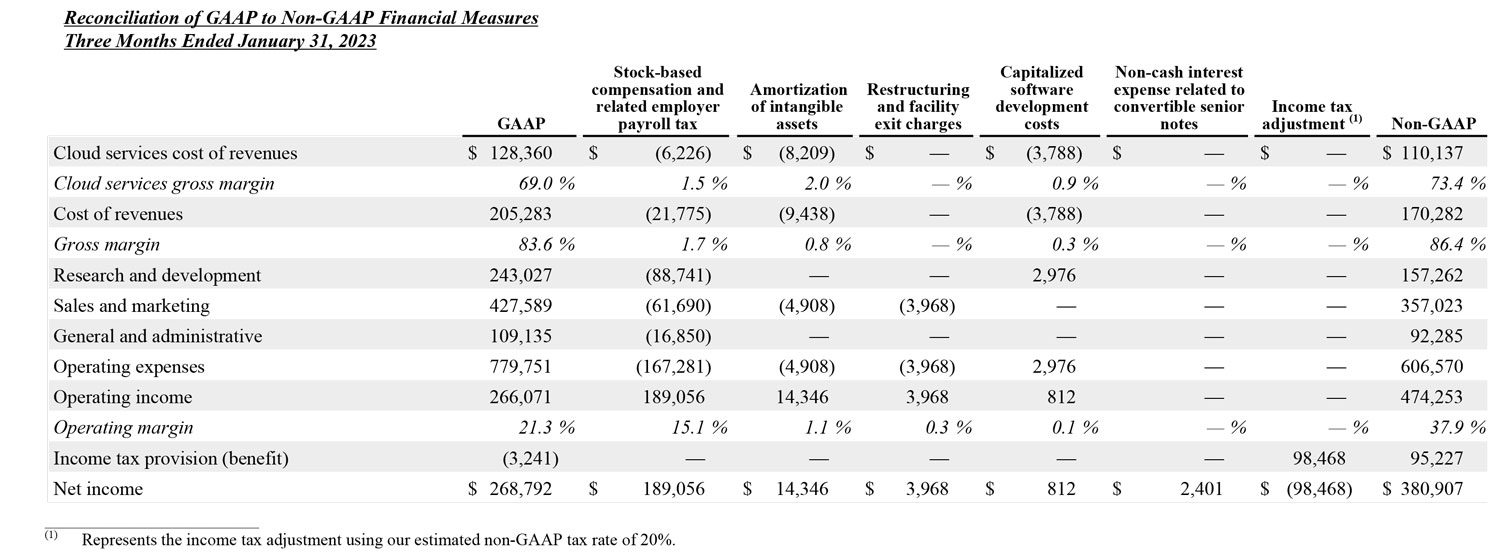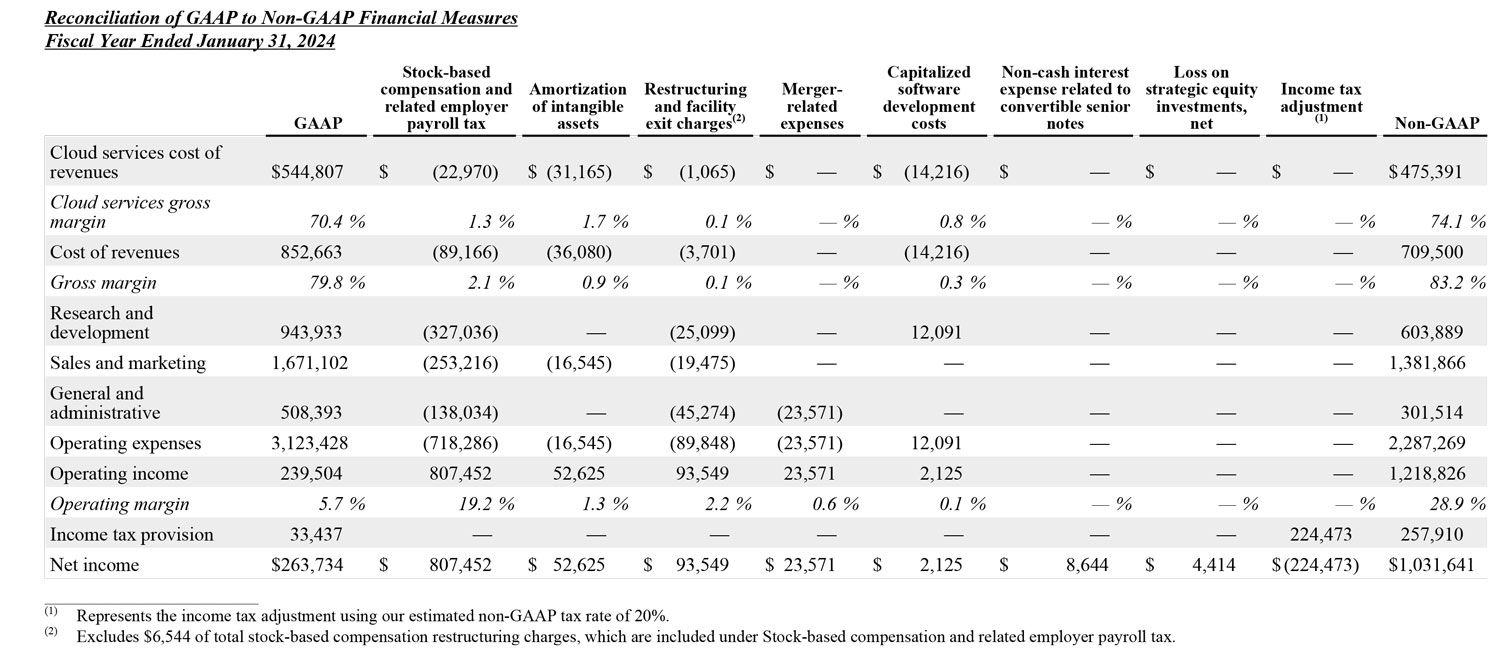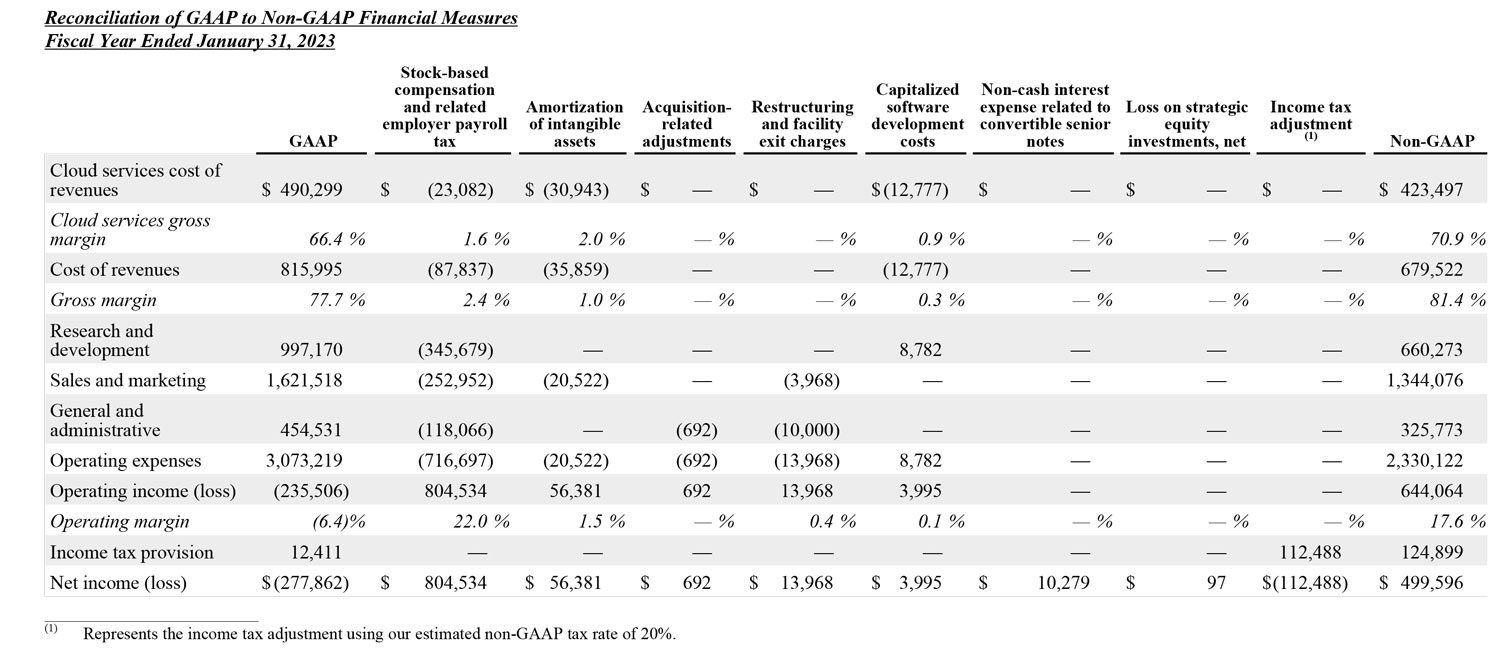February 27, 2024 – Splunk Inc. (NASDAQ: SPLK), the cybersecurity and observability leader, today announced results for its fiscal fourth quarter and full year ended January 31, 2024, as compared to the corresponding period of the last fiscal year:
Fourth Quarter 2024 Financial Highlights
- Total ARR was $4.208 billion, up 15%; Cloud ARR was $2.186 billion, up 23%.
- Total revenues were $1.486 billion, up 19%; Cloud revenue was $503 million, up 22%.
- GAAP operating expenses increased 6.5%; non-GAAP operating expenses decreased 3.1%.
- GAAP operating margin was 29.1%; non-GAAP operating margin was 47.8%.
- GAAP net income was $427 million; non-GAAP net income was $579 million.
- Operating cash flow was $421 million, up 53%; adjusted free cash flow was $418 million, up 56%.
- 899 customers with Total ARR greater than $1 million, an increase of 109 customers.
Full Year 2024 Financial Highlights
- Total revenues were $4.216 billion, up 15%; Cloud revenue was $1.837 billion, up 26%.
- GAAP operating expenses increased 1.6%; non-GAAP operating expenses decreased 1.8%.
- GAAP operating margin was 5.7%; non-GAAP operating margin was 28.9%.
- GAAP net income was $264 million; non-GAAP net income was $1.032 billion.
- Operating cash flow was $1.008 billion, up 124%; adjusted free cash flow was $1.007 billion, up 136%
"We delivered a solid finish to FY24 as our team doubled down on helping organizations worldwide keep their digital systems resilient," said Gary Steele, President and CEO of Splunk. "In Q4, we grew Total ARR to $4.2 billion, and we finished FY24 with nearly 900 customers each generating more than $1 million in ARR. We’re pleased to bring this momentum to Cisco, and we believe there is an incredible opportunity to meet the ever-increasing security and observability needs of the world’s largest and most complex enterprises."
“Q4 was a capstone to a strong year of execution, with ARR growing 15% while we reduced quarterly non-GAAP operating expenses 3% year-over-year. This progress helped drive $427 million of quarterly GAAP net income and over $1 billion of annual adjusted free cash flow, up 136% year-over-year,” said Brian Roberts, CFO of Splunk.
Fourth Quarter Investor Presentation and Stockholder Letter
Visit the Splunk investor relations website to download the company’s quarterly investor presentation, which includes Splunk President and CEO Gary Steele’s letter to stockholders.
Pending Acquisition by Cisco
In light of the pending transaction with Cisco, Splunk will not be hosting an earnings conference call to review the fourth quarter or providing a financial outlook. While the closing of the acquisition by Cisco remains subject to regulatory approvals and conditions, given the positive regulatory approvals to date, the transaction is now expected to close in late Q1 or early Q2 of calendar year 2024.
Recent Business Highlights
- Splunk Security Innovations Strengthen Digital Resilience: Splunk delivered Splunk Enterprise Security 7.3 to provide an enhanced security analyst experience as well as enrich risk context for seamless security incident triage. In addition, Splunk SOAR 6.2 (Security Orchestration Automation and Response) allows users to configure logic loops directly in the Visual Playbook Editor and leverage a new set of firewall management apps.
- Splunk Observability Enhancements Simplify Telemetry Data Collection: Splunk’s latest observability innovation, Splunk Add-On for OpenTelemetry Collector, simplifies getting started with Splunk Observability Cloud and enables additional consistency in how customers manage data collection at scale.
- Hundreds of Public Sector Leaders Attend Splunk’s Annual GovSummit Conference: Public sector partners and customers connected on U.S. national cyber strategy and digital resilience during Splunk’s largest public sector event. A recent Splunk and Foundry survey of cybersecurity professionals revealed 80% of all decision makers said their organizations are using AI to address cybersecurity, and almost half of public sector respondents said they plan to use AI to increase productivity.
Safe Harbor Statement
This press release contains forward-looking statements that involve risks and uncertainties, including statements regarding Splunk’s opportunities; Splunk’s proposed acquisition by Cisco and expected timing of the completion of the acquisition and receipt of regulatory approvals, as well as the benefits of the acquisition; trends in customer demand and engagement as well as Splunk’s operating and financial performance; statements regarding our operating efficiency, growth, profitability and cash flows; statements regarding our products, projects, technology and ongoing product development, including recently announced products; statements regarding our partnerships; statements regarding our market opportunity as well as our ability to meet customer needs; and trends in the markets for our products, including the security and observability markets. There are a significant number of factors that could cause actual results to differ materially from statements made in this press release, including: the risk that the proposed transaction with Cisco is not completed on the anticipated terms or in the time anticipated, including risks related to obtaining regulatory approvals, anticipated tax treatment, unforeseen liabilities, future capital expenditures, revenues, expenses, earnings, synergies, economic performance, indebtedness, financial condition, losses, future prospects, business and management strategies for the management, expansion and growth of Splunk’s business and other conditions to the completion of the transaction; significant transaction costs associated with the proposed transaction; potential litigation relating to the proposed transaction; the risk that disruptions from the proposed transaction will harm Splunk’s business, including current plans and operations; the ability of Splunk to implement its business strategy; the impact of the macroeconomic environment, including inflationary pressures, economic uncertainty and impacts on information technology spending; risks associated with Splunk’s growth; the impact of Splunk’s restructuring plans; risks associated with Splunk’s ability to successfully introduce and gain market acceptance for new products and technologies; Splunk’s inability to realize value from its significant investments in the company’s business, including product and service innovations and through acquisitions; Splunk’s shift from sales of licenses to sales of cloud services which impacts the timing of revenue and margins; Splunk’s transition to a multi-product software and services business; Splunk’s inability to successfully integrate acquired businesses and technologies; Splunk’s inability to service its debt obligations or other adverse effects related to the company’s convertible notes; and general market, political, economic, business and competitive market conditions.
Additional information on potential factors that could affect Splunk’s financial results is included in the company’s Quarterly Report on Form 10-Q for the fiscal quarter ended October 31, 2023, which is on file with the U.S. Securities and Exchange Commission (“SEC”) and Splunk’s other filings with the SEC. Splunk does not assume any obligation to update the forward-looking statements provided to reflect events that occur or circumstances that exist after the date on which they were made.
Splunk Inc. (NASDAQ: SPLK) helps build a safer and more resilient digital world. Organizations trust Splunk to prevent security, infrastructure and application incidents from becoming major issues, absorb shocks from digital disruptions, and accelerate digital transformation.
Splunk and Splunk> are trademarks and registered trademarks of Splunk Inc. in the United States and other countries. All other brand names, product names, or trademarks belong to their respective owners. © 2024 Splunk Inc. All rights reserved.
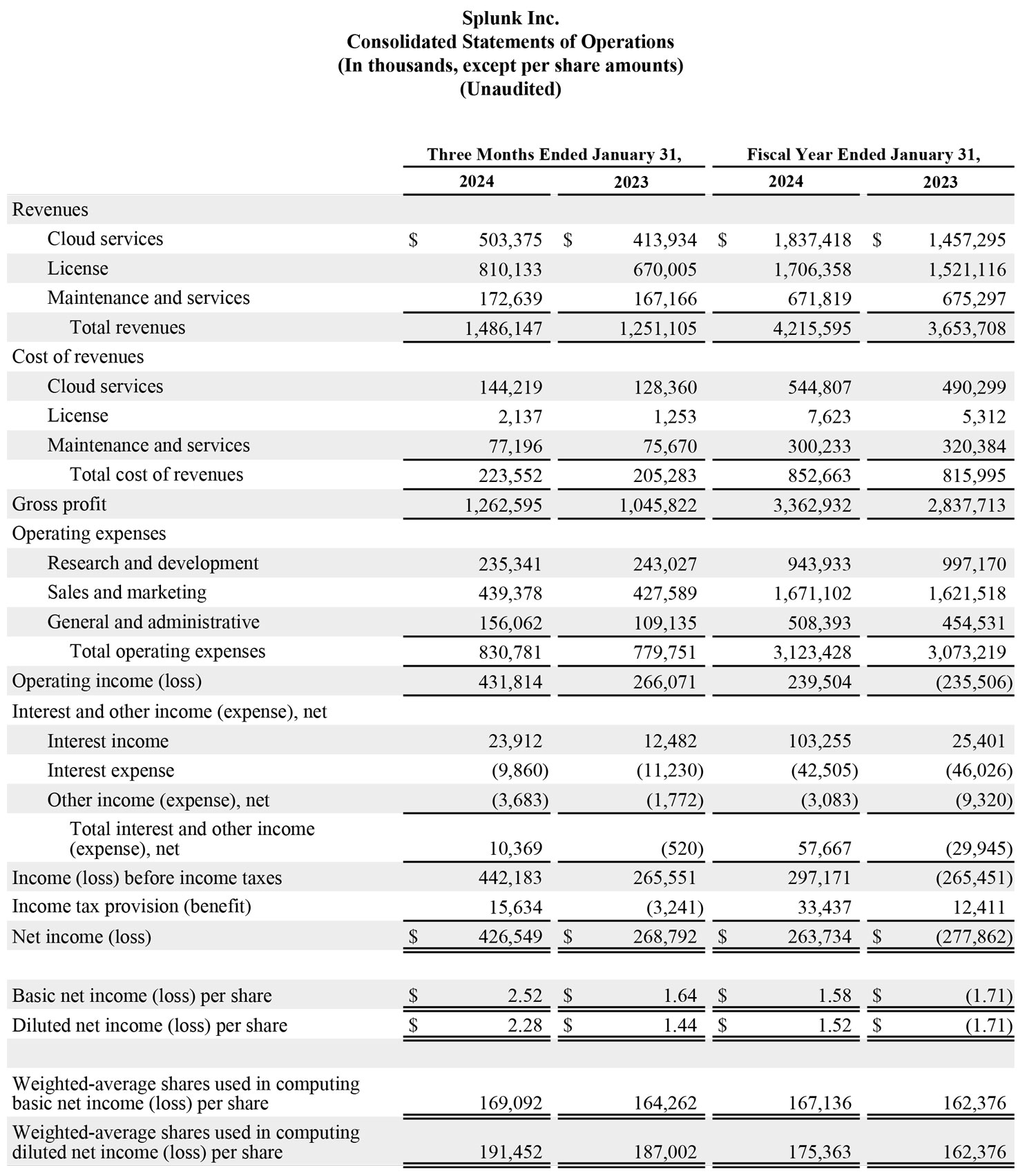
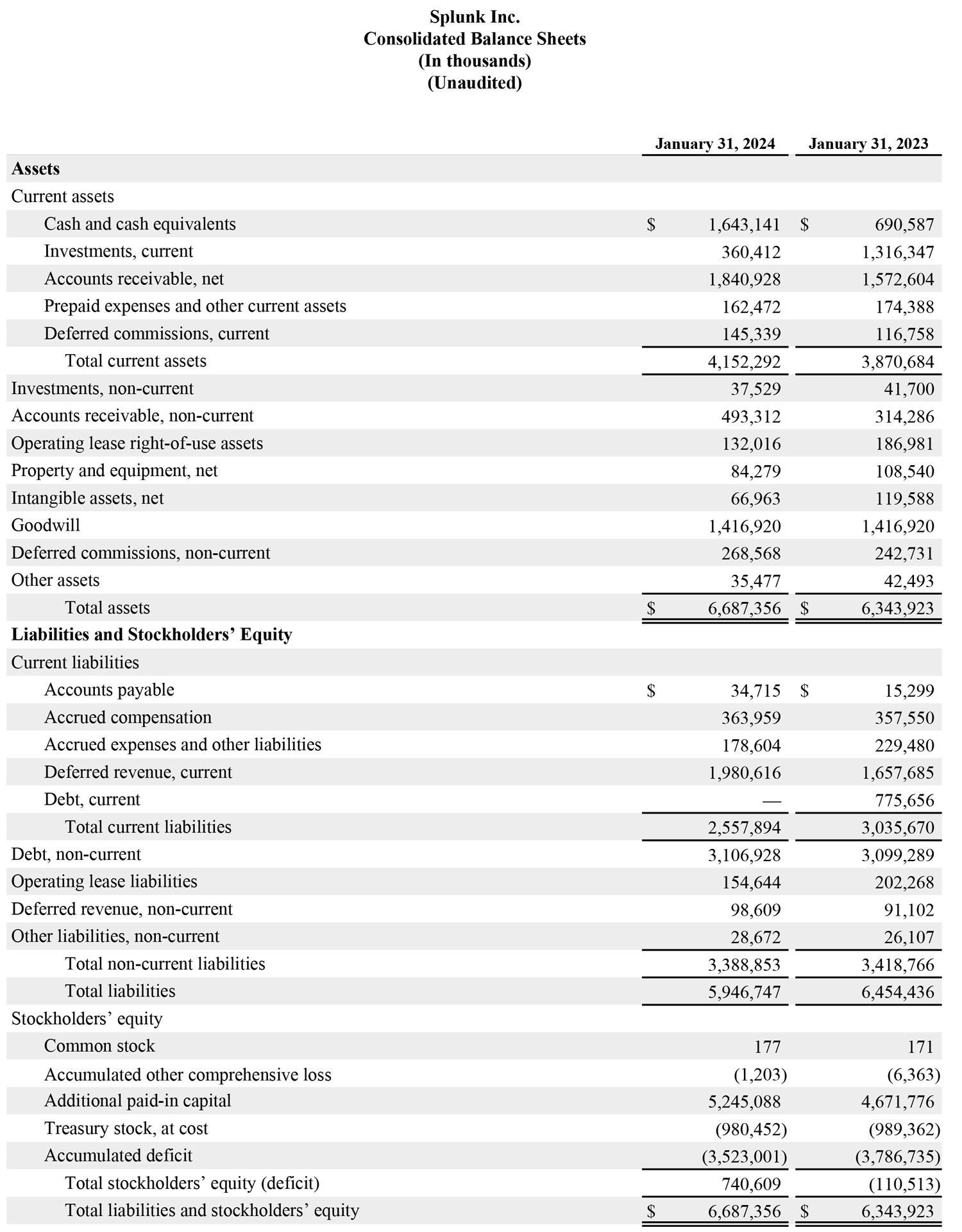
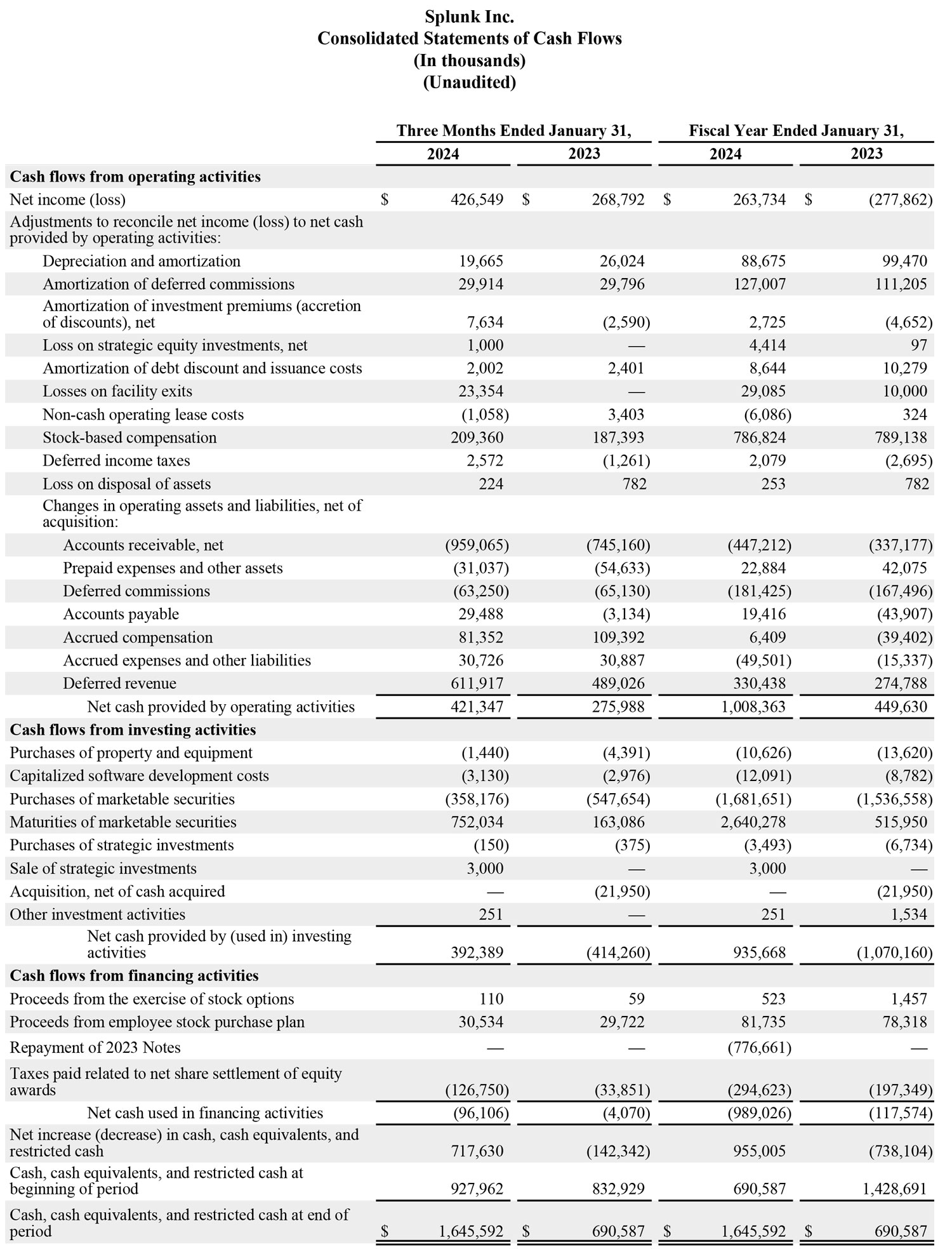
Splunk Inc.
Operating Metrics
Total Annual Recurring Revenue (“Total ARR”) represents the annualized value of active cloud services, term licenses and maintenance contracts at the end of a reporting period. Cloud Annual Recurring Revenue (“Cloud ARR”) represents the annualized value of active cloud services contracts at the end of a reporting period.
Non-GAAP Financial Measures and Reconciliations
To supplement Splunk’s consolidated financial statements, which have been prepared in accordance with generally accepted accounting principles in the United States (“GAAP”), Splunk provides investors with the following non-GAAP financial measures: cloud services cost of revenues, cloud services gross margin, cost of revenues, gross margin, research and development expense, sales and marketing expense, general and administrative expense, operating expenses, operating income (loss), operating margin, income tax provision (benefit), net income (loss), free cash flow and adjusted free cash flow (collectively the “non-GAAP financial measures”). These non-GAAP financial measures exclude all or a combination of the following (as reflected in the following reconciliation tables): expenses related to stock-based compensation and related employer payroll tax, amortization of intangible assets, acquisition-related adjustments, restructuring and facility exit charges, merger-related expenses, capitalized software development costs, non-cash interest expense related to convertible senior notes and a net loss on strategic equity investments. The non-GAAP financial measures are also adjusted for Splunk's current and deferred tax rate on non-GAAP income (loss). Splunk uses a long-term projected non-GAAP tax rate to provide consistency across interim reporting periods. We base our rate on non-GAAP financial projections. In determining our tax rate, we exclude the impact of nonrecurring items, and we make assumptions including those about tax legislation and our tax positions. We applied a 20% non-GAAP tax rate to the three and twelve months ended January 31, 2024 and 2023. In addition, non-GAAP financial measures include free cash flow and adjusted free cash flow. Free cash flow represents net cash provided by operating activities, less purchases of property and equipment and capitalized software development costs. Adjusted free cash flow is a non-GAAP measure that additionally excludes from free cash flow the impact of cash paid for costs incurred as a result of the proposed Cisco merger. Splunk believes that free cash flow and adjusted free cash flow provide investors useful information to better understand the factors and trends affecting the Company’s performance and liquidity. Both of these free cash flow measures have limitations as they omit certain components of the overall cash flow statement and do not represent the residual cash flow available for discretionary expenditures.
Splunk excludes stock-based compensation expense because it is non-cash in nature and excluding this expense provides meaningful supplemental information regarding Splunk’s operational performance and allows investors the ability to make more meaningful comparisons between Splunk’s operating results and those of other companies. Splunk excludes employer payroll tax expense related to employee stock plans in order for investors to see the full effect that excluding that stock-based compensation expense had on Splunk’s operating results. Employer payroll tax expense is tied to the exercise or vesting of underlying equity awards and the price of Splunk’s common stock at the time of vesting or exercise, which may vary from period to period independent of the operating performance of Splunk’s business. Splunk also excludes amortization of intangible assets, acquisition-related adjustments, restructuring and facility exit charges, merger-related expenses, capitalized software development costs, non-cash interest expense related to convertible senior notes and a net loss on strategic equity investments from the applicable non-GAAP financial measures because these adjustments are considered by management to be outside of Splunk’s core operating results. A reconciliation of non-GAAP guidance measures to corresponding GAAP guidance measures is not available on a forward-looking basis without unreasonable effort due to the uncertainty regarding, and the potential variability of, expenses that may be incurred in the future. For example, stock-based compensation-related charges, including related employer payroll tax-related items, are impacted by the timing of employee stock transactions, the future fair market value of our common stock, and our future hiring and retention needs, all of which are difficult to predict and subject to constant change. We have provided a reconciliation of GAAP to non-GAAP financial measures in the financial statement tables for our historical non-GAAP financial results included in this release.
There are limitations in using non-GAAP financial measures because the non-GAAP financial measures are not prepared in accordance with GAAP, may be different from non-GAAP financial measures used by Splunk’s competitors and exclude expenses that may have a material impact upon Splunk’s reported financial results. Further, stock-based compensation expense has been and will continue to be for the foreseeable future, a significant recurring expense in Splunk’s business and an important part of the compensation provided to Splunk’s employees. The presentation of the non-GAAP financial measures is not intended to be considered in isolation or as a substitute for, or superior to, the financial information prepared and presented in accordance with GAAP. Splunk uses these non-GAAP financial measures for financial and operational decision-making purposes and as a means to evaluate period-to-period comparisons. Splunk believes that these non-GAAP financial measures provide useful information about Splunk’s operating results, enhance the overall understanding of past financial performance and future prospects and allow for greater transparency with respect to key metrics used by management in its financial and operational decision making. In addition, these non-GAAP financial measures facilitate comparisons to competitors’ operating results. The non-GAAP financial measures are meant to supplement and be viewed in conjunction with GAAP financial measures.
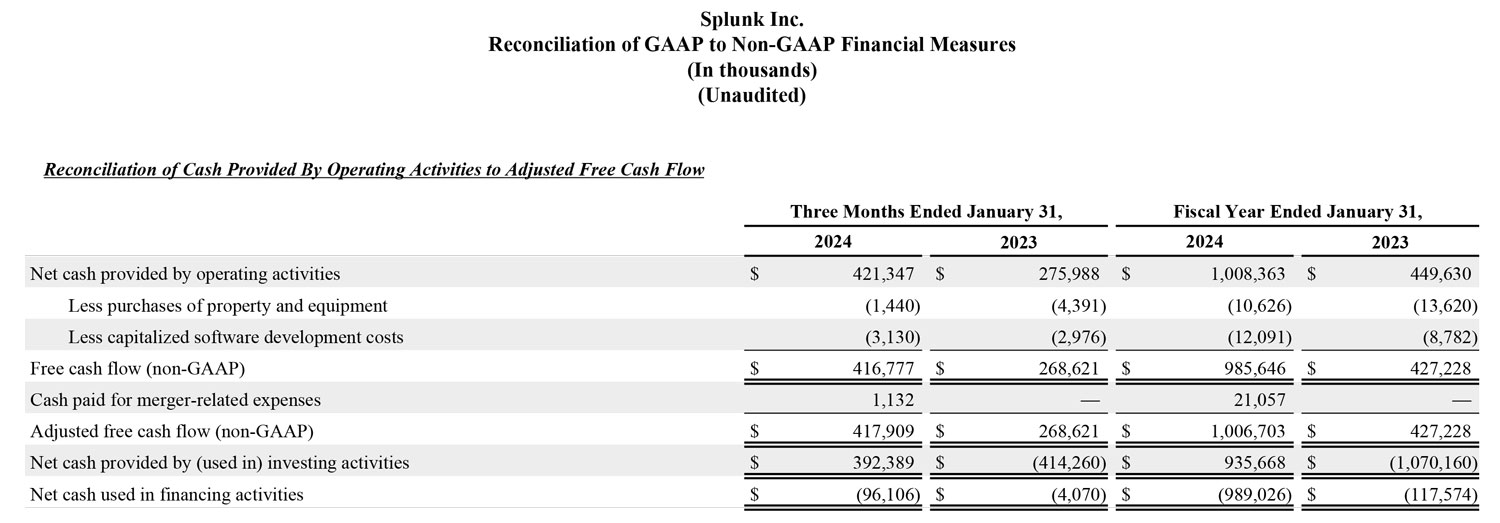
The following tables reconcile Splunk’s GAAP results to Splunk’s non-GAAP results included in this press release.
